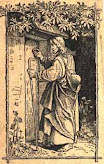Eucharistic Miracle of Macerata Italy (1356)
On April 25, 1356,  at Macerata, a priest whose name is not known was celebrating Mass in the chapel of the Church of St. Catherine, owned by the Benedictine monks. During the breaking of the bread, before Communion, the priest began to doubt the Real Presence of Jesus in the consecrated Host. Precisely in the moment in which he broke the Host, to his great surprise, he saw flow from the Host an abundance of Blood which marked part of the cloth and the chalice place on the altar. At Macerata in the church of the Cathedral of Holy Mary Assumed and St. Giuliano, under the altar of the Most Holy Sacrament, it is possible to venerate the relic of the “corporal marked by blood.” Also preserved in this church is the parchment on which the miracle is described. Furthermore, the historian Ferdinando Ughelli cited this miracle in his work Sacred Italy of 1647 and describes how since the 14th century “the corporal has been carried in solemn procession through the city, enclosed in an urn of crystal and silver, with the concourse of all Piceno.”
at Macerata, a priest whose name is not known was celebrating Mass in the chapel of the Church of St. Catherine, owned by the Benedictine monks. During the breaking of the bread, before Communion, the priest began to doubt the Real Presence of Jesus in the consecrated Host. Precisely in the moment in which he broke the Host, to his great surprise, he saw flow from the Host an abundance of Blood which marked part of the cloth and the chalice place on the altar. At Macerata in the church of the Cathedral of Holy Mary Assumed and St. Giuliano, under the altar of the Most Holy Sacrament, it is possible to venerate the relic of the “corporal marked by blood.” Also preserved in this church is the parchment on which the miracle is described. Furthermore, the historian Ferdinando Ughelli cited this miracle in his work Sacred Italy of 1647 and describes how since the 14th century “the corporal has been carried in solemn procession through the city, enclosed in an urn of crystal and silver, with the concourse of all Piceno.”
 at Macerata, a priest whose name is not known was celebrating Mass in the chapel of the Church of St. Catherine, owned by the Benedictine monks. During the breaking of the bread, before Communion, the priest began to doubt the Real Presence of Jesus in the consecrated Host. Precisely in the moment in which he broke the Host, to his great surprise, he saw flow from the Host an abundance of Blood which marked part of the cloth and the chalice place on the altar. At Macerata in the church of the Cathedral of Holy Mary Assumed and St. Giuliano, under the altar of the Most Holy Sacrament, it is possible to venerate the relic of the “corporal marked by blood.” Also preserved in this church is the parchment on which the miracle is described. Furthermore, the historian Ferdinando Ughelli cited this miracle in his work Sacred Italy of 1647 and describes how since the 14th century “the corporal has been carried in solemn procession through the city, enclosed in an urn of crystal and silver, with the concourse of all Piceno.”
at Macerata, a priest whose name is not known was celebrating Mass in the chapel of the Church of St. Catherine, owned by the Benedictine monks. During the breaking of the bread, before Communion, the priest began to doubt the Real Presence of Jesus in the consecrated Host. Precisely in the moment in which he broke the Host, to his great surprise, he saw flow from the Host an abundance of Blood which marked part of the cloth and the chalice place on the altar. At Macerata in the church of the Cathedral of Holy Mary Assumed and St. Giuliano, under the altar of the Most Holy Sacrament, it is possible to venerate the relic of the “corporal marked by blood.” Also preserved in this church is the parchment on which the miracle is described. Furthermore, the historian Ferdinando Ughelli cited this miracle in his work Sacred Italy of 1647 and describes how since the 14th century “the corporal has been carried in solemn procession through the city, enclosed in an urn of crystal and silver, with the concourse of all Piceno.” 














